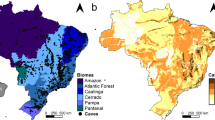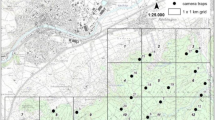Abstract
Bats were netted at two sites over the forest rivers Narewka and Hwoźna in Białowieża Primeval Forest (E Poland), during the summer of 1994 and 1995. A total of 452 bats of 11 species were captured. The number of bats netted each night was positively correlated with the minimum air temperature. The rate at which the three commonest species —Nyctalus noctula, Myotis daubentonii andNyctalus leisleri — were caught varied significantly through the night, with a major peak after sunset. ForN. noctula air temperature was apparently positively related to the size of the morning peak.
Similar content being viewed by others
References
Ahlén I. 1981. Identification of Scandinavian bats by their sounds. Swedish University of Agricultural Sciences, Department of Wildlife Ecology, Uppsala, Report 6: 1–56.
Ahlén I. 1990. Identification of bats in flight. Swedish Society for Conservation of Nature and The Swedish Youth Association for Environmental Studies and Conservation, Stockholm: 1–50.
Aldridge H. D. J. N. 1985. Manoeuvrability and ecology in British bats. Myotis 23–24: 157–160.
Baagoe H. J. 1986. Summer occurrence ofVespertilio murinus Linné, 1758 andEptesicus serotinus (Schreber, 1780) (Chiroptera, Mammalia) on Zealand, Denmark, based on records of roosts and registrations with bat detectors. Annales Naturhistorisches Museum, Wien 88/89: 281–291.
Baagoe H. J. 1987. The Scandinavian bat fauna: adaptive wing morphology and free flight in the field. [In: Recent advances in the study of bats. M. B. Fenton, P. Racey and J. M. V. Rayner, eds]. Cambridge University Press, Cambridge: 57–74.
Bauerova Z. 1978. Contribution to the trophic ecology ofMyotis myotis. Folia Zoologica 27: 305–316.
Bell G. P. 1980. Habitat use and response to patches of prey by desert insectivorous bats. Canadian Journal of Zoology 58: 1876–1883.
Britton A. R. C., Jones G., Rayner J. M. V., Boonman A. M. and Verboom B. 1997. Flight performance, echolocation and foraging behaviour in pond bats,Myotis dasycneme (Chiroptera: Vespertilionidae). Journal of Zoology, London 241: 503–522.
de Jong J. 1994. Distribution patterns and habitat use by bats in relation to landscape heterogeneity, and consequences for conservation. Swedish University of Agricultural Sciences, Department of Wildlife Ecology, Uppsala, Report 26: 1–130.
Erkert H. G. 1982. Ecological aspects of bat activity rhythms. [In: Ecology of bats. T. H. Kunz, ed]. Plenum Press, New York - London 201–242.
Fenton M. B. 1990. Detecting, recording and analyzing vocalizations of bats. [In: Ecological and behavioral methods for the study of bats. T. H. Kunz, ed]. Simthsonian Institution Press, Washington (D.C.): 91–104.
Gaisler J. 1979. Ecology of bats. [In: Ecology of small mammals. D. M. Stoddart, ed]. Chapman and Hall, London: 282–342.
Gerell R. 1999.Myotis mystacinus. [In: The Atlas of European Mammals. A. J. Mitchell-Jones, G. Amori, W. Bogdanowicz, P. J. H. Reijnders, F. Spitzenberger, M. Stubbe, J. B. M. Thissen, V. Vohralik and J. Zima, eds]. Academic Press (for Societas Europaea Mammalogica), London: 116–117.
Gloor S., Stutz H.-P. and Ziswiler V. 1995. Nutritional habits of the noctule batNyctalus noctula (Schreber, 1794) in Switzerland. Myotis 32–33: 231–242.
Kalko E. and Braun M. 1991. Foraging areas as an important factor in bat conservation: estimated capture attempts and success rate ofMyotis daubentonii (Kuhl, 1819). Myotis 29: 55–60.
Kowalski K. and Ruprecht A. L. 1981. Bats — Chiroptera. [In: Keys to vertebrates of Poland. Mammals. Z. Pucek, ed]. PWN (Polish Scientific Publishers), Warszawa: 101–154.
Kronwitter F. 1988. Population structure, habitat use and activity patterns of the Noctule bat,Nyctalus noctula Schreb., 1774 (Chiroptera: Vespertilionidae) revealed by radio-tracking. Myotis 26: 23–85.
Kunz T. H. and Brock C. E. 1975. A comparison of mist nets and ultrasonic detectors for monitoring flight activity of bats. Journal of Mammalogy 56: 907–911.
Kurskov A. N. 1958. [Materials for knowledge about bats of Białowieża Forest]. Trudy Zapovedno--Okhotnichego Khozyaistva “Belovezhkaya Pushcha” 1: 120–138. [In Russian]
Kurskov A. N. 1981. [Bats of Belarus]. Nauka i Tekhnika, Minsk: 1-135. [In Russian] Kurta A. 1982. Flight patterns ofEptesicus fuscus and Myotis lucifugus over a stream. Journal of Mammalogy 63: 335–337.
Limpens H. J. G. A. and Bongers W. 1991. Bats in Dutch forests. Myotis 29: 129–136.
Masing M., Laur T., Leivits A. and Vilbaste H. 1987. Studies on bat migration in Estonia in autumn 1985. Loodusevaatlusi 1985, I: 87–101.
Miller L. A. and Degn H. J. 1981. The acoustic behaviour of four species of bat studied in the field. Journal of Comparative Physiology 142 A: 67–74.
Norberg U. M. and Rayner J. M. V. 1987. Ecological morphology and flight in bats (Mammalia: Chiroptera): wing adaptations, flight performance, foraging strategy and echolocation. Philosophical Transactions of Royal Society (London) B 316: 335–427.
Racey P. A. 1998. The importance of the riparian environment as a habitat for British bats. [In: Behaviour and ecology of riparian mammals. N. Dunstone and M. L. Gorman, eds]. Symposium of Zoological Society of London 71: 69–91.
Rachwald A. 1992. Social organisation, recovery frequency and body weight of the batPipistrellus nathusii from Northern Poland. Myotis 30: 109–118.
Rachwald A. 1998. [Activity and habitat preference of bats in natural tree stands of Białowieża National Park]. Ph D thesis, Warsaw Agricultural University, Warszawa: 1–65. [In Polish]
Rachwald A. and Labocha M. 1996. [Differences concerning bats’ occurence in a natural and cultivated forest in Białowieża Forest (Eastern Poland)]. [In:Aktualne problemy ochrony nietoperzy w Polsce. B. W. Wołoszyn, ed]. CIC, Kraków: 111–122. [In Polish with English summary]
Rachwald A. and Nowakowski W. K. 1994. [The new data about bats in Białowieża Forest]. Przegląd Zoologiczny 38: 117–123. [In Polish]
Řehak Z., Zukal J. and Gaisler J. 1996. Contribution to the knowledge of distribution ofMyotis dasycneme (Mammalia: Chiroptera) in the Czech Republic. Acta Societas Zoologici Bohemia 60: 199–205.
Rörig G. 1918. Die Säugetiere. [In: Bialowies in deutscher Vervaltung]. Verlag Paul Parey, Berlin: 141–171.
Ruprecht A. L. 1965. A rufous specimen ofEptesicus serotinus (Schreber, 1774). Acta Theriologica 10: 239–240.
Ruprecht A. L. 1970.Nyctalus lasiopterus (Schreber, 1780) — a new species in the fauna of Poland. Acta Theriologica 15: 370–372.
Ruprecht A. L. 1976. [The new observations of bats in Białowieża]. Przegląd Zoologiczny 20: 115–123. [In Polish]
Ruprecht A. L. 1983. Bats. [In: Atlas of Polish mammals. Z. Pucek and J. Raczyński, eds]. PWN (Polish Scientific Publishers), Warszawa: 62–82.
Strelkov P. P. 1969. Migratory and stationary bats (Chiroptera) of the European part of the Soviet Union. Acta Zoologica Cracoviensia 14: 393–440.
Stutz H.-P. B. 1999.Myotis myotis. [In: The Atlas of European Mammals. A. J. Mitchell-Jones, G. Amori, W. Bogdanowicz, P. J. H. Reijnders, F. Spitzenberger, M. Stubbe, J. B. M. Thissen, V. Vohralik and J. Zima, eds]. Academic Press (for Societas Europaea Mammalogica), London: 116–117.
Swift S. M. 1991. Brown long-eared batPlecotus auritus. [In: The handbook of British mammals. G. B. Corbett and S. Harris, eds]. 3rd ed., Blackwell Scientific, Oxford: 111–122.
Thomas D. W. and LaVal R. K. 1990. Survey and census methods. [In:Ecological and behavioral methods for the study of bats. T. H. Kunz, ed]. Smithsonian Institution Press, Washington (D.C.): 77–89.
Thomas D. W. and West S. D. 1989. Sampling methods for bats. General technical report PNW-GTR 243, USDA Forest Service, Pacific Northwest Research Station, Portland, OR: 1–20.
Verboom B. 1998. The use of edge habitats by commuting and foraging bats. Ph D thesis, University of Wageningen, Wageningen: 1–123.
Zbinden K. 1989. Field observations on the flexibility of the acoustic behaviour of the European batNyctalus noctula (Schreber, 1774). Revue Suisse de Zoologie 69: 335–243.
Author information
Authors and Affiliations
Rights and permissions
About this article
Cite this article
Rachwald, A., Boratyński, P. & Nowakowski, W.K. Species composition and activity of bats flying over rivers in the Białowieża Primeval Forest. Acta Theriol 46, 235–242 (2001). https://doi.org/10.1007/BF03192431
Received:
Accepted:
Issue Date:
DOI: https://doi.org/10.1007/BF03192431




